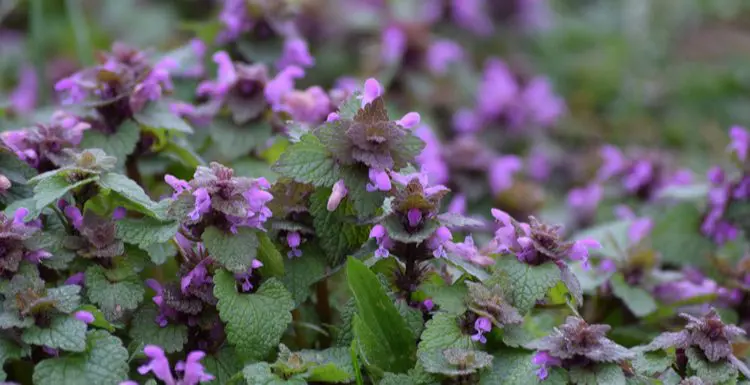Weeds with purple flowers are much more common than you might think.
But worry not—we’ll show you how to identify and remove the most prevalent types in this guide.
Read on to learn all you need to know.
What Are Purple Flowering Weeds?
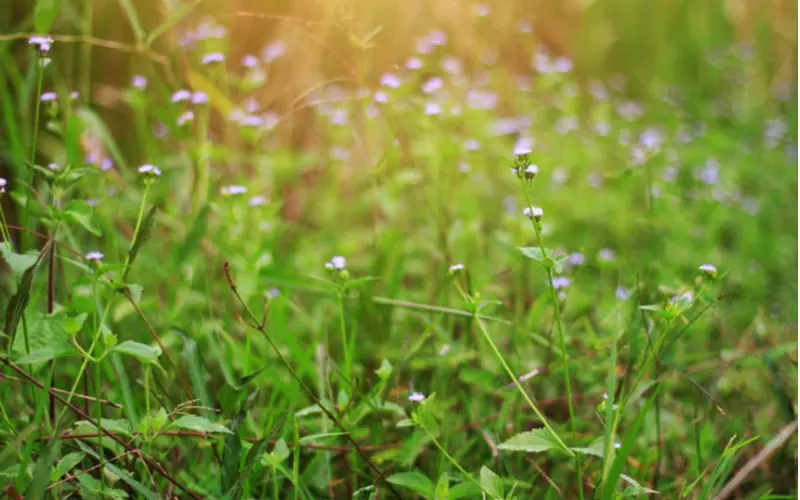
Coco Ratta/Shutterstock
Are you trying to identify what weeds with purple flowers have been popping up in your garden?
Or maybe you’re trying to learn how these weeds affect your plants and what you should do with them to protect your yard.
Don’t worry—you’re in the right place.
If you have weeds with purple flowers growing in your yard, it could be one from our list.
Read on to learn a little about each one, things to consider with each, and a few frequently asked questions.
10 Common Weeds With Purple Flowers
There are many different types of weeds with purple flowers that may be showing up in your garden.
While weeds may have benefits for soils and gardens, they can also be invasive and deplete the water and nutrients that other plants need to grow.
Because of these risks, it’s important to identify what’s growing, weigh the pros and cons, and take steps to control these weeds if needed.
So, what are those weeds with purple flowers in your garden? Here are some ways to identify common weeds that may be growing in your yard:
1. Purple Dead Nettle
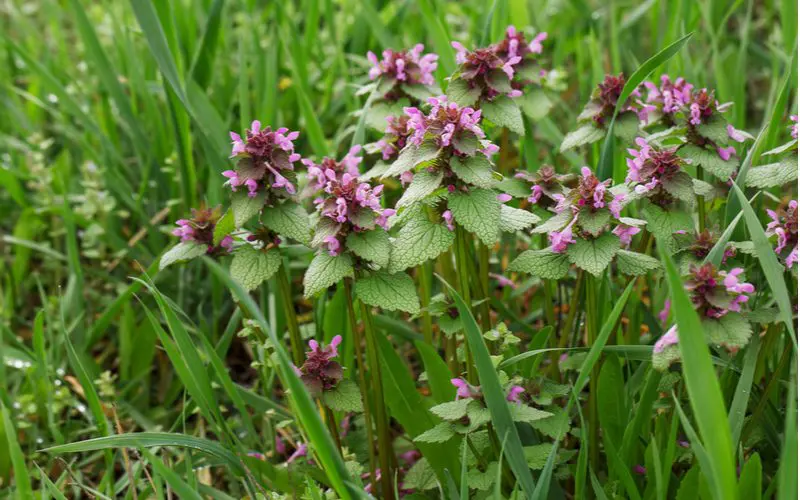
8H/Shutterstock
The Purple Dead Nettle is a member of the mint family, and its purple flowers are mainly seen blooming in April, although a bloom can often continue into late spring and summer.
The Purple Dead Nettle has a square-shaped stem with fuzzy, triangle-shaped leaves that have a reddish-purple hue to them. Their vibrant purple-pink flowers grow in a tubular shape on the upper section of the weed.
While the flowers are vibrant and delicate, these aggressive weeds can grow quickly and are resistant to cold weather, insects, and disease. This allows it to easily spread on moist lawns where it has access to water and sunshine.
These purple flowers are often a critical early food source for pollinators such as honeybees and bumblebees. Because of its ability to help these pollinators, many gardeners may take advantage of the benefits that this creates for bees and gardens.
Even with these benefits, many choose to eradicate this weed, as its durability allows it to quickly take over a lawn.
To prevent the spread of Purple Dead Nettle in your yard, you can use a pre-emergent herbicide in the late fall or winter, as well as proper mowing and fertilization practices in the early spring to reduce the growth of these weeds.
2. Henbit
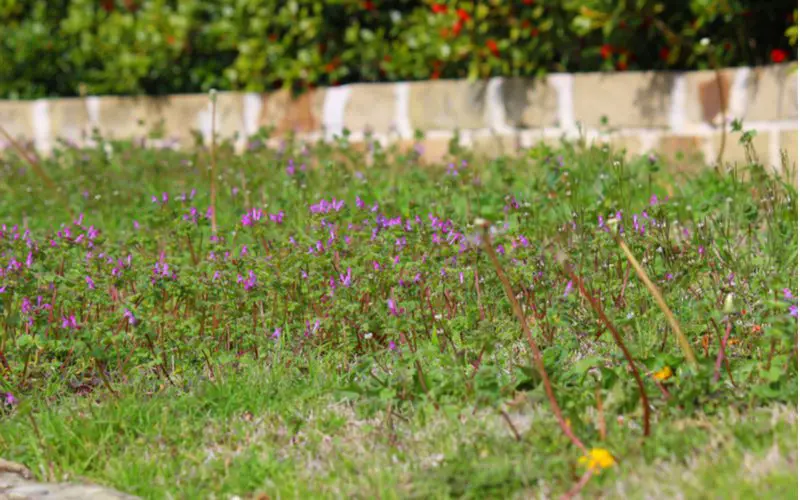
Jasmine Sahin/Shutterstock
Henbit, another member of the mint family, closely resembles Purple Dead Nettle, which often leads to confusion between the two weeds.
Similar to the Purple Dead Nettle, Henbit can grow quickly in moist areas with access to sunlight and is often found growing around ponds or the edge of gardens.
With so many similarities to its close cousin in the mint family, how can you tell them apart?
While Henbit also has a square-shaped stem and purple flowers, it has more round, scallop-edged leaves and is more of a low, droopier creeping weed that stays closer to the ground.
Its flowers also tend to be a darker purple than the Purple Dead Nettle.
Henbit can also be a great source of food for pollinators, but if left alone, it can quickly grow to cover large areas of your yard and deplete resources from grass and other plants.
To prevent and control Henbit, you can use a pre-emergent herbicide in early spring and pull out any Henbit that blooms to help prevent them from spreading throughout your yard.
3. Ground Ivy

Niferure/Shutterstock
Ground ivy, also known as Creeping Charlie, is another distant relative of the mint family that can grow aggressively, even in unfavorable soil conditions.
Ground ivy grows to a height of around 1 inch and quickly forms a low carpet across a garden or lawn, allowing it to scatter its leaves and stems.
Along with the low, creeping stems, you can identify ground ivy by its scalloped leaves and bunches of bright, tubular-shaped purple flowers.
While ground ivy can attract pollinators, it also creates significant ecological threats that you may want to consider.
It’s resistant and grows quickly, and if left undisturbed, it will push out native plants and deprive them of water and nutrients.
You can prevent this from happening by properly mulching and fertilizing your garden in the spring and pulling out any weeds that do find their way into your yard.
4. Wild Violets
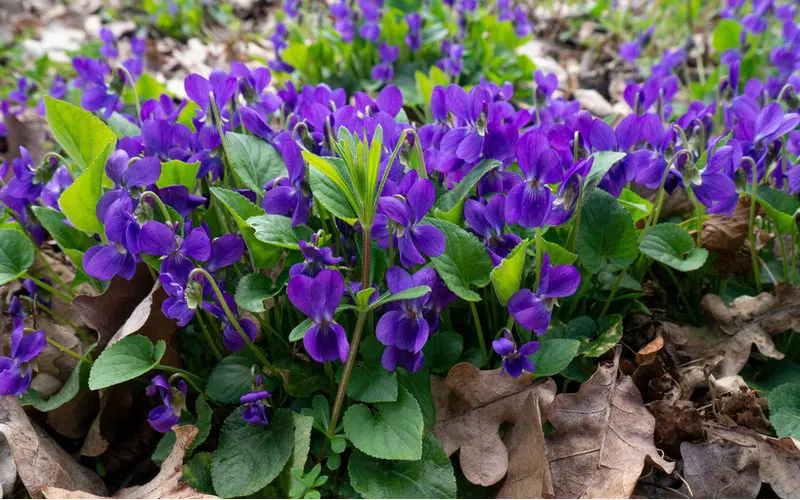
Olexandr Panchenko/Shutterstock
Wild violets, a member of the violet family, is known as one of the most difficult weeds to control in a yard. Wild violets bloom in early spring and can continue to grow and multiply during the warm summer months.
You can identify wild violets by their heart-shaped leaves and purple flowers that bloom close to the ground. While they may be beautiful to look at, they are resilient and adapt well to any conditions, allowing them to easily take over your yard.
Wild violets have thick underground stems called rhizomes that allow them to easily spread through the soil, creating a challenge in preventing their growth.
The best prevention of wild violets is dense, well-maintained grass that prevents spread through rhizomes.
Removing any wild violets that do grow by hand is also an option, but be mindful that you’re pulling up all the roots and disposing of them properly.
Otherwise, they can continue to grow and deplete resources.
5. Forget-Me-Nots
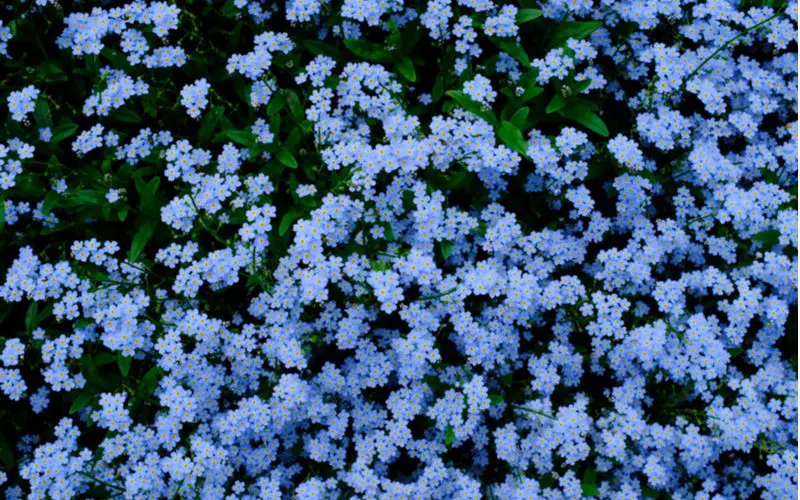
dowraik/Shutterstock
While many gardeners choose to use Forget-Me-Nots as border plantings, these weeds can easily get out of control.
Forget-Me-Nots grows well in moist but drained soil with either shade or sunlight, allowing them to bloom aggressively and take over your garden.
You can identify Forget-Me-Nots by their round, bluish-purple petals and their yellow center.
While they can look beautiful in a garden, they can be extremely invasive and cause harm to other plants if not controlled.
Luckily, you can easily pull out Forget-Me-Nots by hand to help prevent them from taking over your garden.
You can also cultivate the soil in a shaded area to control the spread if you like how they look but want to keep them in check and avoid aggressive spread.
6. Sweet Violets
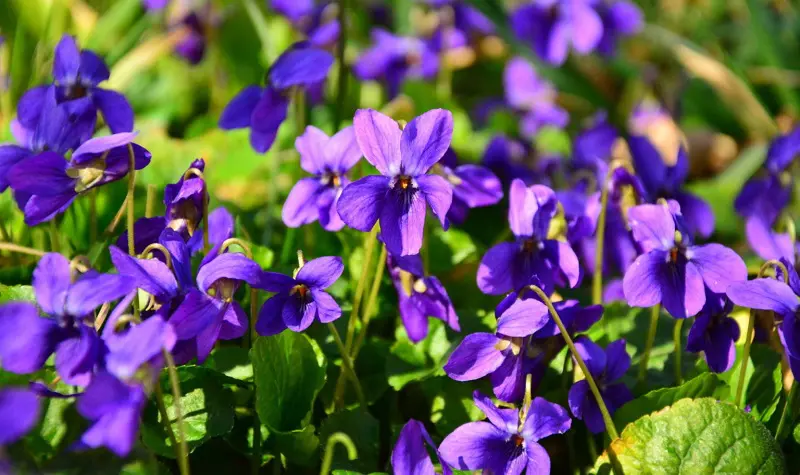
Sweet violets are a weed with some of the prettiest purple flowers. The flowers feature heart-shaped petals in arrangements of five petal clusters. These are perennial plants that thrive in shaded areas of your yard.
While they thrive in the shade, they can also do well in partial shade. Sweet violets grow best when planted in fertile, well-drained, moist soil. Sweet violets are so popular because of how versatile they are.
You can plant them in beds, cottage gardens, containers, or the ground under trees and shrubs. These plants typically grow six to ten inches tall and spread at a moderate pace once well-established in a yard.
This weed with purple flowers is originally from Europe but can grow in other parts of the world if they have the right amount of shade, type of soil, and proper care.
They thrive in the winter and early spring and require little to no maintenance, making them a beautiful and easy addition to your yard.
Something interesting about sweet violets is that the leaves and flowers are edible! While they don’t necessarily taste amazing, they have anti-inflammatory properties. They won’t harm you or a child if they happen to take a bite.
7. Heal-All Plant
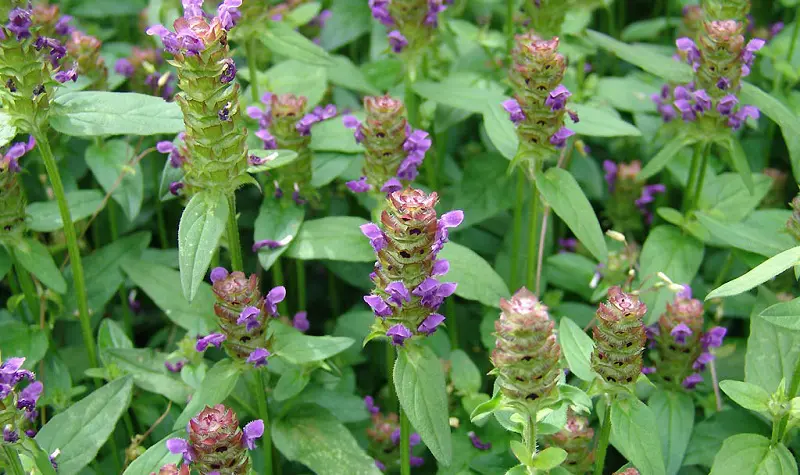
Heal-all plants, sometimes called self-heals, are weeds with two leaves and some pretty, small purple flowers. The flowers form into a two-lipped tube, giving them a unique appearance.
When you look at Heal-All purple flowers, you’ll see green and purple brackets too.
Heal-all plants are perennial herbs that grow well in North America, Europe, Asia, and Africa. While it’s considered an invasive species in Hawaii and other Pacific islands, it grows abundantly in Ireland and is anything but invasive.
You can commonly see these weeds growing on roadsides, but you can plant them in gardens where they’ll spread quickly once well established. The weed can grow in full sun or partial shade, making it versatile.
The plant will grow to 12 to 16 inches tall and is relatively easy to maintain without a professional gardener. They do best when you plant them in medium-moist soil in the spring or summer. These weeds will bloom in the spring and summer.
The weed is in the same family as mint. You can eat the young leaves and stems. Whether you want to eat them raw in a fresh salad or boil them, they are delicious. Just because they’re edible, that doesn’t mean you have to eat them.
8. Violet Wood Sorrel
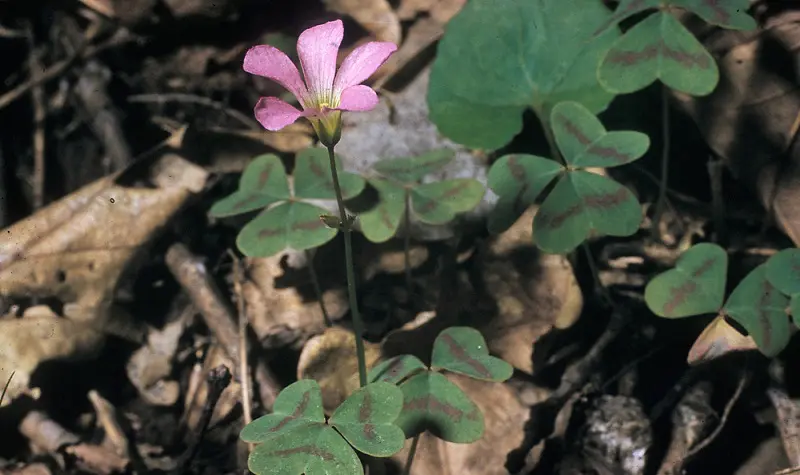
Next up, we have Violet Wood Sorrels. Even though they look just like a flower, they’re technically a weed with flowers. The flowers are beautiful and come in shades of light to dark purple.
This perennial weed is native to North America, and the green parts of the plant look like shamrocks, which are lovely on their own. But when the flowers bloom, Violet Wood Sorrels is a real sight to see.
These weeds can grow anywhere from six to ten inches tall, and once they’re well-established, they’ll spread rapidly.
Suppose you’re thinking about adding violet wood sorrel to your yard or garden. In that case, they’re easy to cultivate and don’t require much maintenance.
The weed grows well in average and mesic to dry, well-drained soil. The best part is that you don’t need to water the weeds constantly.
This versatile plant can thrive in full sunlight or partially shaded garden areas. However, the best time of year to plant these weeds is in the Fall, so the beautiful purple flowers bloom by late spring and early summer.
Violet Wood Sorrel barely has any pests or diseases. However, if you have animals that roam your yard, you’ll want to be careful with these plants because they’re toxic when ingested by dogs, cats, and horses.
9. Canada Thistle
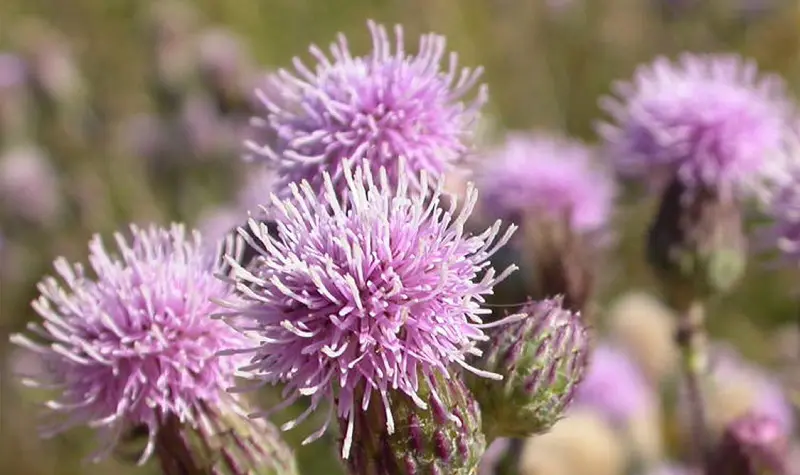
Canada Thistle, also known as Creeping Thistle, is another common weed that features purple flowers when in bloom. The flowers on this weed are different from when you picture a flower in your head.
The weed has sharp spines and spear-shaped leaves that will eventually bloom purple flowers at the top. You’ll often see butterflies, goldfinches, and bees surrounding these flowers in search of nectar.
Canada Thistle is native to Asia and Europe but has been in North America since the 1600s. You’ll see it throughout Canada, hence the name, but in many areas of the United States too. This weed is pretty tall, growing between two and five feet in height.
Mid-July is when you will likely see the purple flowers appearing on Canada Thistle. Still, it depends on the climate of the plant. Like many weeds, Canada thistle is considered a highly invasive plant.
This weed does best in cool soil and needs sunlight to thrive. While sometimes it can grow in partial shade, direct sunlight is the best option for Canada thistle.
A fun fact about Canada Thistle is that previously, people used to make tea with it to help treat tuberculosis.
10. Dove’s-Foot Crane’s-Bill
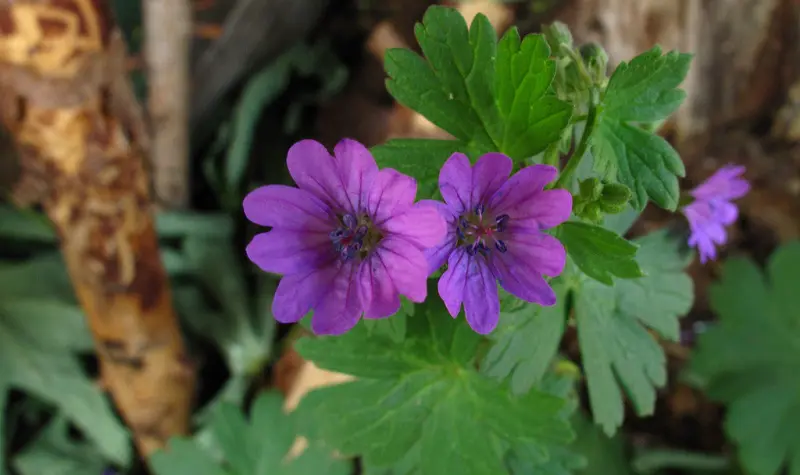
Dove’s-Foot Crane’s-Bill originally came from Europe, but since being introduced to the United States, it’s been found in much of the continental United States. So you’ll find it in all New England states, the South, California, and much of the West Coast.
The flowers on this weed can be lobed or unlobed, but they never separate into leaflets. The weed can grow between three and 16 inches tall and spread quickly through a yard, meadow, or other area.
Generally, this weed doesn’t require much maintenance. Still, when you plant it, you’ll need to ensure that it has plenty of water, especially in a humid environment. In northern states, it thrives in direct sunlight.
In states with a warmer climate, they need extra water and will do better in partial shade to prevent the plant from dying prematurely.
Dove’s-Foot Crane’s-Bill prefers slightly acidic soil, but it can do well in most soil types since it’s a resilient plant. The best times of year to plant new seeds are in spring and fall, so the flowers can bloom shortly after.
Benefits of Weed With Purple Flowers?
Many of these weeds can have benefits for you and your garden.
These include:
- Providing a food source for pollinators
- Benefits for your soil and yard: Some weed roots can actually help fertilize the soil and prevent erosion
- Medicinal benefits: According to the old wives tale, weeds such as Henbit, Ground Ivy, and more can have positive health benefits
Risks of Weed With Purple Flowers?
With these potential advantages, you have to balance the risks that come from many of these purple-flowered weeds.
Possible consequences can include:
- Depletion of nutrients and water from other plants
- Taller weeds block sunlight from your other garden plants
- Invasive weeds can quickly take over a lawn, pushing out other native plant species
Identify Weeds With Purple Flowers
While many of these weeds may share similar characteristics, there are physical differences in their flowers, leaves, and growth patterns that can help you recognize them.
Now that you’ll be able to identify different types of weeds, you can take the correct steps to control their spread and protect your garden and plants.

